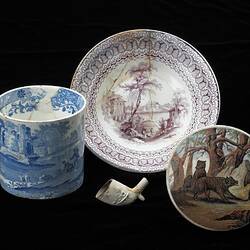Summary
This light-green, glass salad oil bottle was excavated at the Commonwealth Block site between 1988 and 2003. It was manufactured during the 1850s using a two piece vertical mould probably in Britain.
Food and eating.
Kitchen facilities in the homes of Little Lon were rudimentary. Few people had ovens or ice chests, so perishable foods were bought fresh daily. Most meals were fried or boiled over an open fire. Families with limited facilities would take their Sunday roasts to a nearby bakery for cooking. Even the poorest residents of Little Lon seem to have eaten a considerable amount of meat. Mutton, beef, rabbit and pork came from the Eastern Market in Bourke Street. Oysters and fish were sold from barrows in Flinders Street. Fresh fruit and vegetables were hawked on the streets by Chinese and Italian vendors.
Physical Description
This is a light green, salad oil bottle. It has a tapered neck with sloped, fluted shoulders, and a ring where the shoulder meets the body. The body is circular and tapers up. It has a chamfered heel and a shallow concave basal profile. There is a globe embossed on the shoulder.
Physical Description
Light green, salad oil bottle. 2 piece vertical mould. Two part finish with applied lip. Tapered neck with sloped dwn, fluted shoulders, ring where shoulder meets body. Circular body horizontal, tapered up body vertical. Chamfered heel with flat resting point and circular, shallow concave basal profile. Globe embossed on shoulder. Base diameter 50mm, height 250mm. c.1850s, Britain.
More Information
-
Collection Names
-
Collecting Areas
-
Acquisition Information
Transfer from Heritage Victoria, Industry Superannuation Property Trust, 03 May 2005
-
Manufacture Name
-
Manufacture Date
-
Inscriptions
On shoulder: globe (embossed).
-
Context Number
19/45
-
Site
[CCS] Australia, Victoria, Commonwealth Block, Melbourne
-
Activity
-
Specific Activity
-
Decoration
-
Colour
Green, Light
-
Moulding
Multiple
-
Form
Two-part Rim; Cylindrical Body; Shallow Concave (Base)
-
Shape
Round
-
Technique
-
Provenance
Britain
-
Classification
-
Category
-
Discipline
-
Type of item
-
Exhibition Collection Management
63 mm (Width), 253 mm (Height)
Width = Diameter
-
EAMC Measurements
250 (Height), 50 (Outside Diameter)
-
Keywords


